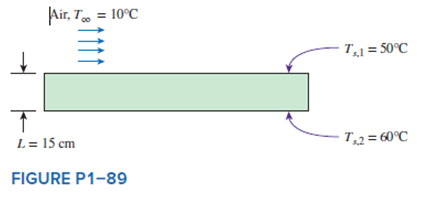A solid plate, with a thickness of 15 cm and a thermal conductivity of 80?W/m•K, is being cooled at the upper surface by air. The air temperature is 10°C, while the temperatures at the upper and lower surfaces of the plate are 50 and 60°C, respectively. Determine the convection heat transfer coefficient of air at the upper surface, and discuss whether the value is reasonable or not for forced convection of air.

The upper surface of a solid plate is being cooled by air. The air convection heat transfer coefficient at the upper plate surface is to be determined.

Assumptions 1 Steady operating conditions exist. 2 Thermal conductivity of the plate is constant. 3 Heat conduction in solid is one-dimensional. 4 Temperatures at the surfaces remained constant.
Properties The thermal conductivity of the solid plate is given as k = 80 W/m?K.
Analysis Applying energy balance on the upper surface of the solid plate

The convection heat transfer of the air is

Discussion A convection heat transfer coefficient of 133 W/m2?K for forced convection of gas is reasonable when compared with the values listed in Table 1-5.
You might also like to view...
The ____________________ system is effective because it has a means of recognizing any type of foreign tissue or organism that invades the body
Fill in the blank(s) with correct word
Which character of the VIN indicates the engine code?
A) Tenth B) Eighth C) First D) None of these
If 18 V and 6 V sources are connected in series opposing, what is the total voltage?
A) 18 V B) 12 V C) 6 V D) 2 V
When cutting thin steel with oxyfuel cutting equipment, point the torch tip in the direction the torch is
traveling at a _____. a. 10- to 12-degree angle b. 15- to 20-degree angle c. 21- to 25-degree angle d. 30- to 35-degree angle